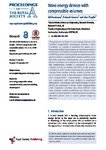Wave energy devices with compressible volumes
| dc.contributor.author | Kurniawan, A | |
| dc.contributor.author | Greaves, D | |
| dc.contributor.author | Chaplin, J | |
| dc.date.accessioned | 2015-06-25T10:25:53Z | |
| dc.date.available | 2015-06-25T10:25:53Z | |
| dc.date.issued | 2014-10-22 | |
| dc.identifier.issn | 1364-5021 | |
| dc.identifier.issn | 1471-2946 | |
| dc.identifier.other | 20140559 | |
| dc.identifier.uri | http://hdl.handle.net/10026.1/3384 | |
| dc.description | EPSRC SuperGen Marine Energy Research Consortium EP/K012177/1 | |
| dc.description.abstract |
We present an analysis of wave energy devices with air-filled compressible submerged volumes, where variability of volume is achieved by means of a horizontal surface free to move up and down relative to the body. An analysis of bodies without power take-off (PTO) systems is first presented to demonstrate the positive effects a compressible volume could have on the body response. Subsequently, two compressible device variations are analysed. In the first variation, the compressible volume is connected to a fixed volume via an air turbine for PTO. In the second variation, a water column separates the compressible volume from another volume, which is fitted with an air turbine open to the atmosphere. Both floating and bottom-fixed, axisymmetric, configurations are considered, and linear analysis is employed throughout. Advantages and disadvantages of each device are examined in detail. Some configurations with displaced volumes less than 2000 m3 and with constant turbine coefficients are shown to be capable of achieving 80% of the theoretical maximum absorbed power over a wave period range of about 4 s. | |
| dc.format.extent | 0-0 | |
| dc.format.medium | ||
| dc.language | en | |
| dc.language.iso | en | |
| dc.publisher | Royal Society, The | |
| dc.subject | wave energy | |
| dc.subject | compressible volume | |
| dc.subject | axisymmetric device | |
| dc.subject | numerical modelling | |
| dc.subject | absorbed power | |
| dc.title | Wave energy devices with compressible volumes | |
| dc.type | journal-article | |
| dc.type | Article | |
| plymouth.author-url | https://www.ncbi.nlm.nih.gov/pubmed/25484609 | |
| plymouth.issue | 2172 | |
| plymouth.volume | 470 | |
| plymouth.publication-status | Published | |
| plymouth.journal | Proceedings of Royal Society A | |
| dc.identifier.doi | 10.1098/rspa.2014.0559 | |
| plymouth.organisational-group | /Plymouth | |
| plymouth.organisational-group | /Plymouth/Faculty of Science and Engineering | |
| plymouth.organisational-group | /Plymouth/Faculty of Science and Engineering/School of Engineering, Computing and Mathematics | |
| plymouth.organisational-group | /Plymouth/PRIMaRE Publications | |
| plymouth.organisational-group | /Plymouth/REF 2021 Researchers by UoA | |
| plymouth.organisational-group | /Plymouth/REF 2021 Researchers by UoA/UoA12 Engineering | |
| plymouth.organisational-group | /Plymouth/Research Groups | |
| plymouth.organisational-group | /Plymouth/Research Groups/Marine Institute | |
| plymouth.organisational-group | /Plymouth/Users by role | |
| plymouth.organisational-group | /Plymouth/Users by role/Academics | |
| plymouth.organisational-group | /Plymouth/Users by role/Researchers in ResearchFish submission | |
| dc.publisher.place | England | |
| dcterms.dateAccepted | 2014-09-25 | |
| dc.identifier.eissn | 1471-2946 | |
| dc.rights.embargoperiod | Not known | |
| rioxxterms.funder | EPSRC | |
| rioxxterms.identifier.project | The hydrodynamics of deformable flexible fabric structures for wave energy conversion | |
| rioxxterms.versionofrecord | 10.1098/rspa.2014.0559 | |
| rioxxterms.licenseref.uri | http://www.rioxx.net/licenses/all-rights-reserved | |
| rioxxterms.licenseref.startdate | 2014-12-08 | |
| rioxxterms.type | Journal Article/Review | |
| plymouth.funder | The hydrodynamics of deformable flexible fabric structures for wave energy conversion::EPSRC |


